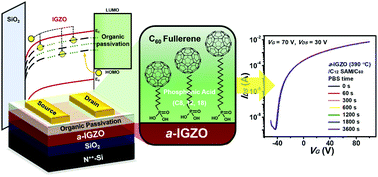Microstructural modulation of organic passivation layers for metal oxide semiconductors to achieve high bias stability†
Abstract
Electrical properties of metal oxide thin-film transistors (TFTs) are tuned via the microstructural control of organic back-channel passivation layers. In this study, organic semiconductor (OSC) passivation layers with various molecular and physicochemical properties are employed to identify the back-channel passivation mechanism in solution-processed amorphous indium gallium zinc oxide (a-IGZO) TFTs. The OSC microstructure influences the passivation of electrical defects in a-IGZO TFTs by compensating for acceptor-like trap states and dangling bonds in the back-channel. First, the distance between an n-type OSC (C60) and the a-IGZO back-channel is controlled by employing phosphonic acid molecules with different carbon chain lengths. Positive bias stress stability is tuned by applying both the OSC and carbon chain effect, leading to stable, high-performance TFTs with the determination of subgap density of states to confirm the compensation effects on the total acceptor-like defect states. The n-doping of identical passivation layers is further investigated by using perylenedicarboximide derivatives to confirm the proposed n-doping mechanism. Finally, the semiconductor 4,4-difluoro-4-bora-3a,4a-diaza-s-indacene is selected on the basis of our proposed passivation model and exhibited good passivation characteristics. This study demonstrates an ideal molecular design for organic passivation layers, which shows significant potential for the realization of stable, high-performance TFTs.



 Please wait while we load your content...
Please wait while we load your content...